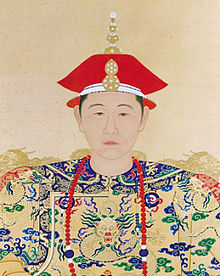Kangxi Emperor. A portrait of the Kangxi emperor in court dress, from a silk scroll hanging in the Palace Museum in Beijing.
The main army of the Qing Empire, the Eight Banners Army, was in decline under Kangxi. It was smaller than it had been at its peak under Hong Taiji and in the early reign of the Shunzhi Emperor; however, it was larger than in the Yongzheng and Qianlong emperors’ reigns. In addition, the Green Standard Army was still powerful with generals such as Tuhai, Fei Yanggu, Zhang Yong, Zhou Peigong, Shi Lang, Mu Zhan, Shun Shike and Wang Jingbao. The Kangxi Emperor in ceremonial armor, armed with bow and arrows, and surrounded by bodyguards
The main reason for this decline was a change in system between Kangxi and Qianlong’s reigns. Kangxi continued using the traditional military system implemented by his predecessors, which was more efficient and stricter. According to the system, a commander who returned from a battle alone (with all his men dead) would be put to death, and likewise for a foot soldier. This was meant to motivate both commanders and soldiers alike to fight valiantly in war because there was no benefit for the sole survivor in a battle.
By Qianlong’s reign, military commanders had become lax and the training of the army was deemed less important as compared to during the previous emperors’ reigns. This was because commanders’ statuses had become hereditary; a general gained his position based on the contributions of his forefathers.
#
The Treaty of Nerchinsk, 1689, was China’s first treaty with Russia and was important because it settled the boundary between the two empires and began diplomatic relations on an equal footing. In the mid- 17th century, Russia’s eastward conquest across Siberia reached the Amur River region on the boundary of the newly established Qing (Ch’ing) Empire in China. In 1675, Russia sent Nicolai G. Spathary as ambassador to the Chinese court, and he was received by the Kangxi (K’ang-hsi) emperor; he learned all he could about China but otherwise returned home empty-handed.
Kangxi’s early years were focused on suppressing a serious revolt in southern and southwestern China (called the Revolt of the Three Feudatories, ended in 1681) and the Ming loyalist movement on Taiwan (ended in 1683). Next he dealt with Russia’s advance to areas claimed by China by ordering General Pengcun, at the head of 10,000 soldiers, 5,000 sailors, and 200 pieces of artillery, to take on the small Russian force at Albazin in 1685, which he captured and then returned home. The reinforced Russians however returned, rebuilt their fort at Albazin, and continued to raid the Amur region. China did not wish to continue a protracted conflict that might drive the yet unpacified Olod Mongols to the Russian fold.
Thus the two countries agreed to negotiations at Nerchinsk in 1688. The Chinese delegation was headed by Prince Songgotu and had two Jesuit priests, Jean- François Gerbillon and Thomas Pereira, as interpreters. The Russian delegation was led by Fedor A. Golovin. Each delegation was supported by a large contingent of soldiers, the Chinese one being much larger. The Treaty of Nerchinsk was signed on September 7, 1689. It had six articles and was in five languages, Chinese, Manchu, Mongolian, Russian, and Latin, with the Latin version being the official text. The treaty delineated the boundary between Russian Siberia and Chinese Manchuria along the Argun and Amur Rivers to the mouth of the Kerbechi, and along the Outer Xingan (Hsing-an, Stenovoi in Russian) to the sea. The Russian-built fort at Albazin was to be demolished and Russian residents there were to be repatriated. It also provided for the right of residence and trade between peoples of the two countries, the issuing of passports, and the extradition of fugitives.
The Treaty of Nerchinsk was negotiated between two equal countries. Russia gained 93,000 square miles of hitherto disputed territory that included Nerchinsk while China secured Albazin and peace with Russia that would allow it to deal with and eventually defeat the western or Olod Mongols. Most significantly it regularized Chinese- Russian relations and began the periodic exchange of diplomatic missions between the two countries.
Further reading: Mancall, Mark. Russia and China: Their Diplomatic Relations to 1728. Cambridge, MA: Harvard University Press, 1971; Sebes, Joseph S. The Jesuits and the Sino-Russian Treaty of Nerchinsk, 1689: The Diary of Thomas Pereira. Rome: Institutum Historicum, 1961.
